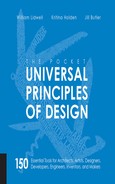122 Selection Bias
A bias in the way evidence is collected that distorts analysis and conclusions.
• Selection bias results from the non-random sampling of evidence. Accordingly, it over-represents certain aspects of the evidence and under-represents others, distorting analysis and conclusions.
• For example, if subscribers of a science magazine are surveyed and their responses generalized to the overall population, science-minded viewpoints would be over-represented in the analysis and results.
• Avoid selection bias. Collect data from entire populations when they are small. Randomly sample from populations when they are large.
• Scrutinize the selected population and sampling methods when evaluating conclusions based on statistical analysis.
See Also Confirmation Bias • Garbage In-Garbage Out Normal Distribution • Uncertainty Principle
The red dots indicate areas of combat damage received by surviving WWII bombers. Where would you add armor to increase survivability? The statistician Abraham Wald recommended reinforcing the areas without damage. Since these data came from surviving aircraft only, bombers hit in undotted areas were the ones that did not make it back.

